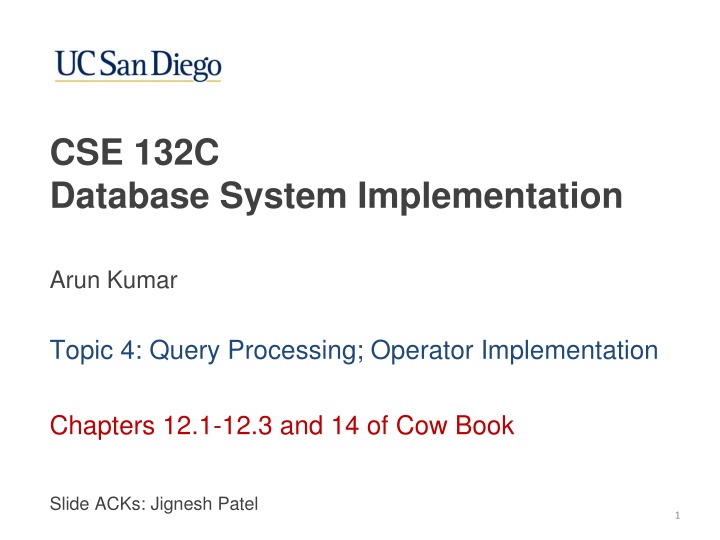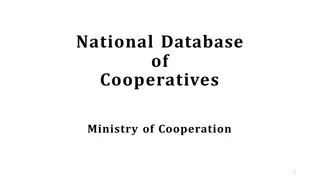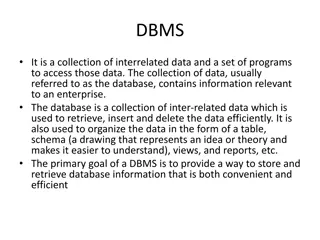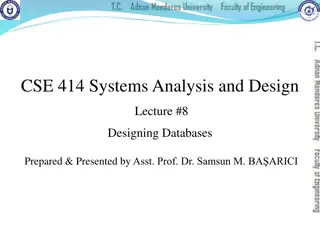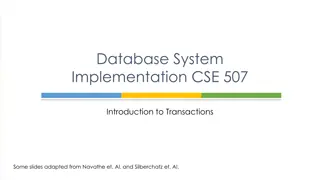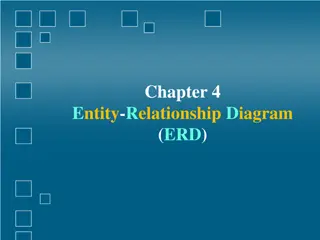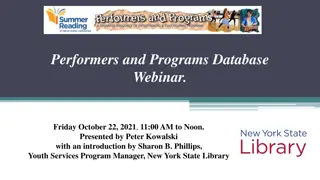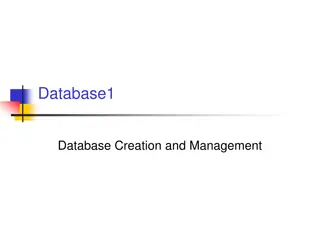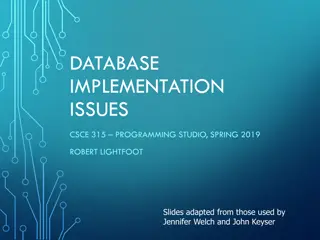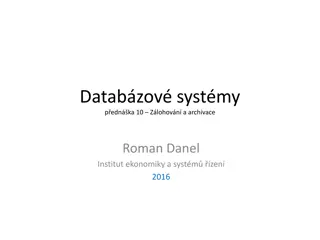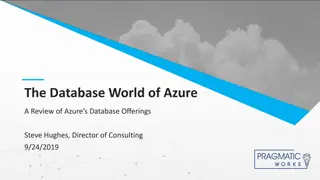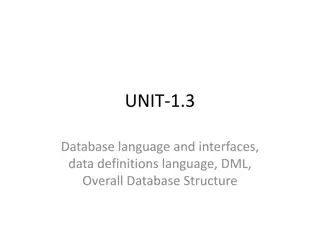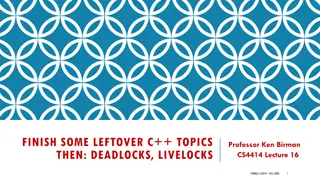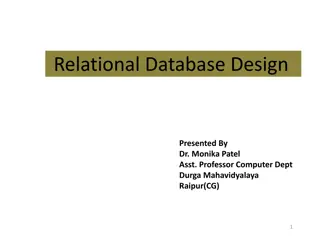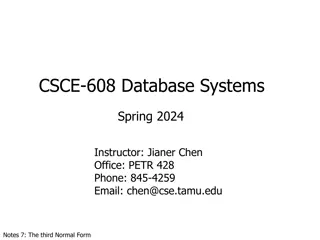CSE 132C Database System Implementation
This content delves into the lifecycle of a query, from processing to execution, using examples from the Netflix schema. It explores logical and physical query plans, showcasing different implementations and the importance of declarative querying in system design. The progression from logical to physical separation in database management systems is highlighted, emphasizing the impact on user productivity and performance optimizations.
Download Presentation

Please find below an Image/Link to download the presentation.
The content on the website is provided AS IS for your information and personal use only. It may not be sold, licensed, or shared on other websites without obtaining consent from the author.If you encounter any issues during the download, it is possible that the publisher has removed the file from their server.
You are allowed to download the files provided on this website for personal or commercial use, subject to the condition that they are used lawfully. All files are the property of their respective owners.
The content on the website is provided AS IS for your information and personal use only. It may not be sold, licensed, or shared on other websites without obtaining consent from the author.
E N D
Presentation Transcript
CSE 132C Database System Implementation Arun Kumar Topic 4: Query Processing; Operator Implementation Chapters 12.1-12.3 and 14 of Cow Book Slide ACKs: Jignesh Patel 1
Lifecycle of a Query Query Result Query Database Server Query Scheduler Execute Operators Parser Optimizer | | | ..| ..| | | | ..| ..| | | | ..| ..| | | | ..| ..| | | | ..| ..| | | | ..| ..| | | | ..| ..| | | | ..| ..| | | | ..| ..| | | | ..| ..| | | | ..| ..| Query Result Select R.text from Report R, Weather W where W.image.rain() and W.city = R.city and W.date = R.date and R.text. matches( insurance claims ) Query Syntax Tree and Logical Query Plan Physical Query Plan Segments 2
Recall the Netflix Schema Ratings RatingID 1 Stars 3.5 RateDate 08/27/15 UID 79 MID 20 Users UID 79 80 Name Alice Bob Age 23 41 JoinDate 01/10/13 05/10/13 Movies MID 20 16 Name Inception Avatar Year 2010 2009 Director Christopher Nolan Jim Cameron 3
Example SQL Query RatingID UID MID Stars Name Name RateDate Age UID MID JoinDate Year Director SELECT FROM WHERE GROUP BY M.Year ORDER BY NumBest DESC M.Year, COUNT(*) AS NumBest Ratings R, Movies M R.MID = M.MID AND R.Stars = 5 Suppose, we also have a B+Tree Index on Ratings (Stars) 4
Logical Query Plan Result Table SORT On NumBest Called Logical Operators GROUP BY AGGREGATE M.Year, COUNT(*) From extended RA Each one has alternate physical implementations JOIN R.MID = M.MID SELECT R.stars = 5 SELECT No predicate Ratings Table Movies Table 5
Physical Query Plan Result Table External Merge-Sort In-mem quicksort; B=50 Called Physical Operators Hash-based Aggregate Specifies exact algorithm/code to run for each logical operator, with all parameters (if any) Index-Nested Loop Join Indexed Access Use Index on Stars File Scan Read heapfile This is one of many physical plans possible for a query! Ratings Table Movies Table 6
Logical-Physical Separation in DBMSs Logical = Tells you what is computed Physical = Tells you how it is computed Declarativity! Declarative querying (logical-physical separation) is a key system design principle from the RDBMS world: Declarativity often helps improve user productivity Enables behind-the-scenes performance optimizations People are still (re)discovering the importance of this key system design principle in diverse contexts (MapReduce/Hadoop, networking, file system checkers, interactive data-vis, graph systems, large-scale ML, etc.) 7
Operator Implementations Select Project Need scalability to larger-than- memory (on-disk) datasets and high performance at scale! Join Set Operations Group By Aggregate 8
But first, what metadata does the RDBMS have? 9
System Catalog Set of pre-defined relations for metadata about DB (schema) For each Relation: Relation name, File name File structure (heap file vs. clustered B+ tree, etc.) Attribute names and types; Integrity constraints; Indexes For each Index: Index name, Structure (B+ tree vs. hash, etc.); IndexKey For each View: View name, and View definition 10
Statistics in the System Catalog RDBMS periodically collects stats about DB (instance) For each Table R: Cardinality, i.e., number of tuples, NTuples (R) Size, i.e., number of pages, NPages (R), or just NR or N For each Index X: Cardinality, i.e., number of distinct keys IKeys (X) Size, i.e., number of pages IPages (X) (for a B+ tree, this is the number of leaf pages only) Height (for tree indexes) IHeight (X) Min and max keys in index ILow (X), IHigh (X) 11
Operator Implementations Select Project Need scalability to larger-than- memory (on-disk) datasets and high performance at scale! Join Set Operations Group By Aggregate 12
Selection: Access Path Access path: how exactly is a table read ( accessed ) Two common access paths: File scan: Read the heap/sorted file; apply SelectCondition I/O cost: O(N) Indexed: Use an index that matches the SelectCondition I/O cost: Depends! For equality check, O(1) for hash index, and O(log(N)) for B+-tree index 13
Indexed Access Path R RatingID Stars RateDate UID MID 14
Selectivity of a Predicate Selectivity of SelectionCondition = percentage of number of tuples in R satisfying it (in practice, count pages, not tuples) R RatingID 2 39 12 402 293 49 66 Stars 3.0 5.0 2.5 5.0 2.5 1.0 2.5 RateDate UID MID Selectivity = 2/7 ~ 28% Selectivity = 3/7 ~ 43% Selectivity = 1/7 ~ 14% 15
Selectivity and Matching Indexes An Index matches a predicate if it brings I/O cost very close to (N * predicate s selectivity); compare to file scan! R RatingID 2 39 12 402 293 49 66 Stars 3.0 5.0 2.5 5.0 2.5 1.0 2.5 RateDate UID MID N x Selectivity = 2 Hash index on R(Stars) Cl. B+ tree on R(Stars) Uncl. B+ tree on R(Stars)? Assume only one tuple per page 16
Matching an Index: More Examples R RatingID Stars RateDate UID MID Hash index on R(Stars) does not match! Why? Cl. B+ tree on R(Stars) still matches it! Why? Cl. B+ tree on R(Stars,RateDate)? Cl. B+ tree on R(Stars,RateDate,MID)? Cl. B+ tree on R(RateDate,Stars)? Uncl. B+ tree on R(Stars)? B+ tree has a nice prefix-match property! 17
Prefix Matching for CNF Predicates Express SelectionCondition in Conjunctive Normal Form (CNF), i.e., Pred1 AND Pred2 AND (each is a conjunct ) Given IndexKey k of B+ tree index, if any prefix subset of k appears in any conjunct, it matches the predicate Example: Conjunct is a prefix of IndexKey IndexKey is a subset of Conjunct: Primary Conjunct IndexKey (UID, Stars)? (Stars, UID)? IndexKey (UID, Stars, MID)? IndexKey (Stars, UID, MID)? IndexKey (MID, UID, Stars)? IndexKey UID? IndexKey Stars? 18
More Examples for Index Matching R RatingID Stars RateDate UID MID Cl. B+ tree index on R(UID,Stars,MID)? Cl. B+ tree index on R(Stars,MID,UID)? Hash index does not have the prefix- match property of a B+ tree index! Hash index on R(UID,Stars)? Hash index on R(UID,Stars,MID)? Hash index on R(Stars,MID,UID)? Hash index on R(UID)? On R(Stars)? Primary conjuncts! 19
Matching an Index: Multiple Matches R RatingID Stars RateDate UID MID Cl. B+ tree index on R(UID,Stars)? What if we also have an index (hash or tree) on MID? Multiple indexes match non-identical portions of predicate We can use both indexes and intersect the sets of RecordIDs! Sometimes, unions of RecordID sets for disjunctions 20
Matching an Index: More Examples Given hash index on <a> and hash index on <b> Predicate: (a = 7 OR b < 5) Given hash index on <a> and cl. B+ tree index on <b> Which index matches? Neither! Recall CNF! Predicate: (a = 7 AND b < 5) Both! Can intersect RecordIDs! Given hash index on <a> and cl. B+ tree index on <b> Which index matches? Predicate: (a = 7 OR c > 10) AND (b < 5) Which index matches? Only B+ tree on b 21
Operator Implementations Select Project Need scalability to larger-than- memory (on-disk) datasets and high performance at scale! Join Set Operations Group By Aggregate 22
Project R RatingID Stars RateDate UID MID SELECT R.MID, R.Stars FROM Ratings R Trivial to implement! Read R and discard other attributes I/O cost: NR, i.e., Npages(R) (ignore output write cost) SELECT DISTINCT R.MID, R.Stars FROM Ratings R Relational Project! Need to deduplicate tuples of (MID,Stars) after discarding other attributes; but these tuples might not fit in memory! 23
Project: 2 Alternative Algorithms Sorting-based: Idea: Sort R on ProjectionList (External Merge Sort!) 1. In Sort Phase, discard all other attributes 2. In Merge Phase, eliminate duplicates Let T be the temporary table after step 1 I/O cost: NR + NT + EMSMerge(NT) Hashing-based: Idea: Build a hash table on R(ProjectionList) 24
Hashing-based Project To build a hash table on R(ProjectionList), read R and discard other attributes on the fly If the hash table fits entirely in memory: Done! I/O cost: NR Needs B >= F x NT Q: What is the size of a hash table built on a P-page file? F x P pages ( Fudge factor F ~ 1.4 for overheads) If not, 2-phase algorithm: Partition Deduplication 25
Original R Partitions of T OUTPUT Hashing 1 1 2 INPUT hash func. h1 2 Assuming uniformity, size of a T partition = NT / (B-1) Size of a hash table on a partition = F x NT / (B-1) Thus, we need: (B-2) >= F x NT / (B-1) Rough: . . . B-1 B-1 B buffer pages Disk Disk Partition phase Partitions of T Output Hash table for partition i hash func. h2 h2 I/O cost: NR + NT + NT Output buffer Input buffer for partition i B buffer pages Deduplication phase If B is smaller, need to partition recursively! Disk Disk 26
Project: Comparison of Algorithms Sorting-based vs. Hashing-based: 1. Usually, I/O cost (excluding output write) is the same: NR + 2NT (why is EMSMerge(NT) only 1 read?) 2. Sorting-based gives sorted result ( nice to have ) 3. I/O could be higher in many cases for hashing (why?) In practice, sorting-based is popular for Project If we have any index with ProjectionList as subset of IndexKey Use only leaf/bucket pages as the T for sorting/hashing If we have tree index with ProjectionList as prefix of IndexKey Leaf pages are already sorted on ProjectionList (why?) Just scan them in order and deduplicate on the fly! 27
Operator Implementations Select Project Need scalability to larger-than- memory (on-disk) datasets and high performance at scale! Join Set Operations Group By Aggregate 28
Join This course: we focus primarily on equi-join (the most common, important, and well-studied form of join) R U RatingID Stars RateDate UID MID UserID Name Age JoinDate We study 4 major (equi-) join implementation algorithms: Page/Block Nested Loop Join (PNLJ/BNLJ) Index Nested Loop Join (INLJ) Sort-Merge Join (SMJ) Hash Join (HJ) 29
Nested Loop Joins: Basic Idea Brain-dead idea: nested for loops over the tuples of R and U! 1. For each tuple in Users, tU : 2. For each tuple in Ratings, tR : 3. If they match on join attribute, stitch them, output But we read pages from disk, not single tuples! 30
Page Nested Loop Join (PNLJ) Brain-dead nested for loops over the pages of R and U! 1. For each page in Users, pU : 2. For each page in Ratings, pR : 3. Check each pair of tuples from pR and pU 4. If any pair of tuples match, stitch them, and output U is called Outer table R is called Inner table Outer table should be the smaller one: NU NR I/O Cost: Q: How many buffer pages are needed for PNLJ? 31
Block Nested Loop Join (BNLJ) Basic idea: More effective usage of buffer memory (B pages)! 1. For each sequence of B-2 pages of Users at-a-time : 2. For each page in Ratings, pR : 3. Check if any pR tuple matches any U tuple in memory 4. If any pair of tuples match, stitch them, and output I/O Cost: Step 3 ( brain-dead in-memory all-pairs comparison) could be quite slow (high CPU cost!) In practice, a hash table is built on the U pages in-memory to reduce #comparisons (how will I/O cost change above?) 32
Index Nested Loop Join (INLJ) Basic idea: If there is an index on R or U, why not use it? Suppose there is an index (tree or hash) on R (UID) 1. For each sequence of B-2 pages of Users at-a-time : 2. Sort the U tuples (in memory) on UserID 3. For each U tuple tU in memory : 4. Lookup/probe index on R with the UserID of tU 5. If any R tuple matches it, stitch with tU, and output I/O Cost: NU + NTuples(U) x IR Index lookup cost IR depends on index properties (what all?) A.k.a Block INLJ (tuple/page INLJ are just silly!) Q: Why does step 2 help? Why not buffer index pages? 33
Sort-Merge Join (SMJ) Basic idea: Sort both R and U on join attr. and merge together! 1. Sort R on UID 2. Sort U on UserID 3. Merge sorted R and U and check for matching tuple pairs 4. If any pair matches, stitch them, and output I/O Cost: EMS(NR) + EMS(NU) + NR + NU If we have enough buffer pages, an improvement possible: No need to sort tables fully; just merge all their runs together! 34
Sort-Merge Join (SMJ) Basic idea: Obtain runs of R and U and merge them together! 1. Obtain runs of R sorted on UID (only Sort phase) 2. Obtain runs of U sorted on UserID (only Sort phase) 3. Merge all runs of R and U together and check for matching tuple pairs 4. If any pair matches, stitch them, and output I/O Cost: 3 x (NR + NU) # runs after steps 1 & 2 ~ NR/2B + NU/2B So, we need B > (NR + NU)/2B Just to be safe: How many buffer pages needed? NU NR 35
Review Questions! R U RatingID Stars RateDate UID MID UID Name Age JoinDate Given tables R and U with NR = 1000, NU = 500, NTuples(R) = 80,000, and NTuples(U) = 25,000. Suppose all attributes are 8 bytes long (except Name, which is 40 bytes). Let B = 400. Let UID be uniformly distributed in R. Ignore output write costs. 1. What is the I/O cost of projecting R on to Stars (with deduplication)? 2. What are the I/O costs of BNLJ and SMJ for a join on UID? 3. What are the I/O costs of BNLJ and SMJ if B = 50 only? 4. Whichbuffer replacement policy is best for BNLJ, if B = 800? 36
Hash Join (HJ) Basic idea: Partition both on join attr.; join each pair of partitions 1. Partition U on UserID using h1() 2. Partition R on UID using h1() 3. For each partition of Ui : 4. Build hash table in memory on Ui 5. Probe with Ri alone and check for matching tuple pairs 6. If any pair matches, stitch them, and output NU NR U becomes Inner table R is now Outer table I/O Cost: 3 x (NU + NR) This is very similar to the hashing-based Project! 37
Partitions of U Original U OUTPUT Hash Join 1 1 2 INPUT hash func. h1 2 Similarly, partition R with same h1 on UID NU NR . . . B-1 B-1 B buffer pages Partition phase Memory requirement: (B-2) >= F x NU / (B-1) Rough: Disk Disk Partitions of U and R Output hash func. h2 Hash table on Ui I/O cost: 3 x (NU + NR) Q: What if B is lower? Q: What about skews? Q: What if NU > NR? h2 Output buffer Input buffer for Ri B buffer pages Stitching Phase Disk Disk Hybrid Hash Join algorithm exploits memory better and has slightly lower I/O cost 38
Join: Comparison of Algorithms NU NR Block Nested Loop Join vs Hash Join: Identical if (B-2) > F x NU! Why? I/O cost? Otherwise, BNLJ is potentially much higher! Why? Sort Merge Join vs Hash Join: To get I/O cost of 3 x (NU + NR), SMJ needs: But to get same I/O cost, HJ needs only: Thus, HJ is often more memory-efficient and faster Other considerations: HJ could become much slower if data has skew! Why? SMJ can be faster if input is sorted; gives sorted output Query optimizer considers all these when choosing phy. plan B buffer pages 39
Join: Crossovers of I/O Costs We plot the I/O costs of BNLJ, SMJ, and HJ 8GB memory; 8KB pages (So, B = 1m) Arity of both R and U = 40 |U| = 5m; NU ~ 195K |R| = 500m; NR ~ 19.5M |U| = 5m; NU ~ 195K I/O cost in pages fails Usually, HJ dominates! NTuples(R) / 5m Vary buffer memory
More General Join Conditions NA NB If JoinCondition has only equalities, e.g., A.a1 = B.b1 and A.a2 = B.b2 HJ: works fine; hash on (a1, a2) SMJ: works fine; sort on (a1, a2) INLJ: use (build, if needed) a matching index on A What about disjunctions of equalities? If JoinCondition has inequalities, e.g., A.a1 > B.b1 HJ is useless SMJ and INLJ are also mostly unhelpful! Why? Inequality predicates might lead to large outputs! 41
Operator Implementations Select Project Need scalability to larger-than- memory (on-disk) datasets and high performance at scale! Join Set Operations Group By Aggregate 42
Set Operations Similar to intersection, but need to deduplicate upon matches and output only once! Sounds familiar? 43
Operator Implementations Select Project Need scalability to larger-than- memory (on-disk) datasets and high performance at scale! Join Set Operations Group By Aggregate 45
Group By Aggregate Grouping Attributes (Subset of R s attributes) A numerical attribute in R Aggregate Function (SUM, COUNT, MIN, MAX, AVG) Easy case: X is empty! Simply aggregate values of Y Difficult case: X is not empty Collect groups of tuples that match on X, apply Agg(Y) 3 algorithms: sorting-based, hashing-based, index-based Q: How to scale this to larger-than-memory data? 46
Group By Aggregate: Easy Case All 5 SQL aggregate functions computable incrementally, i.e., one tuple at-a-time by tracking some running information RatingID 2 39 12 402 293 49 66 Stars 3.0 5.0 2.5 5.0 2.5 1.0 2.5 3.0; 8.0; 10.5; 15.5; 18.0; 19, 21.5 SUM: Partial sum so far COUNT is similar MAX: Maximum seen so far MIN is similar 3.0; 5.0 3.0; 2.5; 1.0 Q: What about AVG? Track both SUM and COUNT! In the end, divide SUM / COUNT 47
Group By Aggregate: Difficult Case Collect groups of tuples (based on X) and aggregate each MID UID 21 55 80 21 55 55 21 55 Stars 3.0 5.0 2.5 5.0 2.0 1.0 4.0 4.0 21 21 21 3 3.0 5.0 4.0 AVG for 21 is 4.0 3 32 11 294 12 32 24 19 11 123 55 55 55 55 294 24 19 123 5.0 2.0 1.0 4.0 AVG for 55 is 3.0 AVG for 80 is 2.5 80 12 2.5 Q: How to collect groups? Too large? 48
Group By Agg.: Sorting-Based 1. Sort R on X (drop all but X U {Y} in Sort phase to get T) 2. Read in sorted order; for every distinct value of X: 3. Compute the aggregate on that group ( easy case ) 4. Output the distinct value of X and the aggregate value I/O Cost: NR + NT + EMSMerge(NT) Q: Which other sorting-based op. impl. had this cost? Improvement: Partial aggregations during Sort Phase! Q: How does this reduce the above I/O cost? 49
Group By Agg.: Hashing-Based 1. Build h.t. on X; bucket has X value and running info. 2. Scan R; for each tuple in each page of R: 3. If h(X) is present in h.t., update running info. 4. Else, insert new X value and initialize running info. 5. H.t. holds the final output in the end! I/O Cost: NR Q: What if h.t. using X does not fit in memory (Number of distinct values of X in R is too large)? 50
